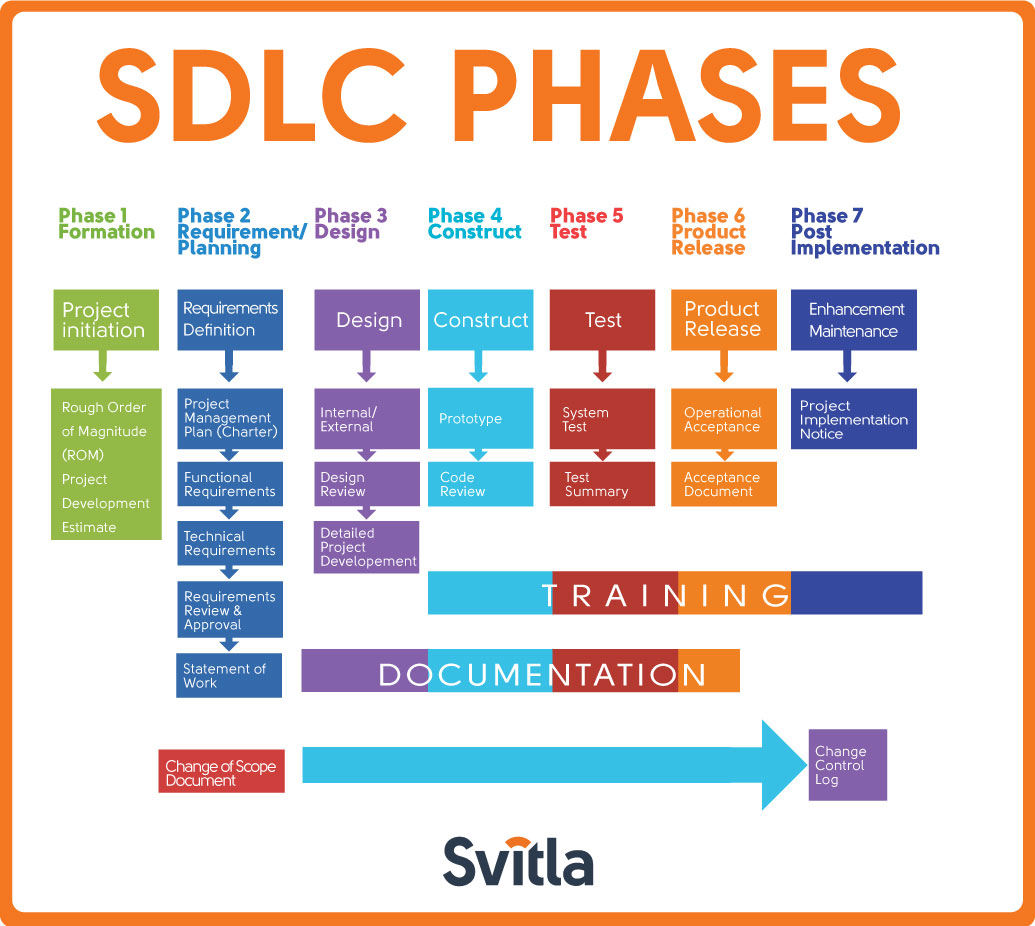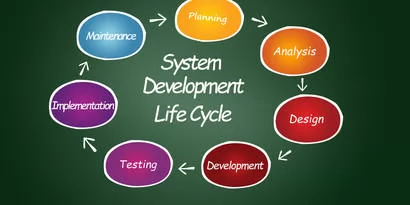
SDLC Methodologies
Every day, software engineers and professionals must immerse themselves into the dynamics of the best Software Development Lifecycle (SDLC) methodology and approach to develop and deliver software in optimum conditions. But what are the nuts and bolts of SDLC methodologies?
Table of contents:
- What is SDLC?
- The Software Development Process.
- Importance of SDLC methodologies on a project.
- Selecting the right SDLC methodology for a project.
- Popular SDLC models.
- Conclusion.
- Why Svitla?
What is SDLC?
Software development is the bread and butter of software engineers and developers. According to “A Down-To-Earth Guide to SDLC Project Management,” the System/Software Development Life Cycle (SDLC) is “a project life cycle that is tailored specifically towards the creation, alteration, and maintenance of software applications, hardware platforms, and information technology systems.”
SDLC methodologies provide a systematic framework to design, develop and deliver software applications from beginning to end. It is a series of steps offering a foundation for software development. A structure to build software is fundamental, which is why there are multiple software development methodologies to choose from. It is increasingly important for software engineers to select the right SDLC model that meets specific requirements and concerns of the project to drive success. In this article, we go into the details of SDLC methodologies, their relevance, their advantages, disadvantages, and everything in between.
To a certain extent, you can think about SDLC methodologies as a checklist of the different stages that must be performed to develop and deliver successful software applications. All SDLC methodologies share a common ground of distinct phases: planning, analysis, design, building, testing, deploying, and maintenance. These SDLC phases provide the outline of what a software application project entails.
In the following section, we will explore how software development lifecycles impact the software development process.
The Software Development Process
As with all great projects, the software development process starts with an idea. It takes planning, preparation, and management of phases and team members to reach a goal. SDLC is a mapped-out, regulated framework that typically follows the following universal stages to deliver high-quality software applications.
SDLC phases
The SDLC chart clearly shows the sequence of phases and stages in software development. This graph shows how team members switch from one stage to another and what results must be available to move successfully to the next SDLC phase. In this case, according to the chart, you can perform specific actions in parallel.
SVITLA PRO TIP: For your development methodology, it is strongly recommended that you develop an SDLC diagram and share it with all team members.
 Formation phase
Formation phase
This introductory phase is the inception of an idea for a solution that improves an existing solution or develops an entirely new one. It helps define the magnitude of the project to plan resources.
Requirement/Planning Phase
This phase gathers requirements to formulate a design plan for the software application solution. It entails a thorough analysis to assess user needs, feasibility, development, improvements, and more. During the planning phase, it is vital to include documentation to refine requirements and keep a record of the solution’s development. This phase involves the creation of a project charter that defines technical and functional requirements.
Design Phase
This phase focuses on the design aspect of the software application solution in terms of the selected technical and functional requirements and the results of the thorough analysis of the software’s viability.
Development Phase
This phase is the “meat” of the software development process. In this phase, software engineers focus solely on building a prototype of the solution to perform a code review and ultimately create the solution. The team works on transforming software specifications into a working and reliable solution.
Testing Phase
This crucial phase tests the software to ensure everything works as intended. In the testing phase, software engineers can detect defects, bugs, and errors in the software solution and ultimately have a quality product that meets business expectations. Quality Assurance (QA) specialists perform a series of tests to evaluate the status of the solution.
The testing phase in SDLC is a crucial stage of any software development project. Rigorous QA starts with the first phase and initial deliverables to establish a quality-centered expectation and lead by example. The entire information system's performance depends on this phase. You can critically damage your entire project, loss or misinterpret user data, or temporarily suspend a system by not prioritizing the testing phase. Poor testing practices can lead to enormous losses and damage your software's quality.
Release Phase
Once the software application is fully developed and tested, it moves to the release phase. It’s best practice (and genuine wisdom!) to do practice releases prior to the actual release as a way to find and fix defects. Admittedly, each phase, and in particular this Release phase, should include sessions to share the team’s lessons learned.
When thoroughly tested and ready, the software goes live and is released to the end user for actual use of the product. The software is fully operational in a live environment where end-users utilize it.
Maintenance Phase
This post-release phase is tasked with keeping the software completely operational, updating it to meet quality standards, and enhancing it throughout its life to ensure it continues to attract and retain users.
The software development process sets the tone and defines a goal from which developers kick-start a project. Ultimately, following a software development process is intended to develop software faster and with as few hiccups as possible.
SDLC project management is an essential aspect of the overall process. As the system development project manager, it's your job to keep the organization's management doing the work and everyone on your team up to date on how the project is going. Three things come with this responsibility:
- Telling everyone about important milestones.
- Reporting progress as often as needed.
- Finding a way to show how valuable everyone's contribution is to project management.
Now that we’ve covered the universal SDLC phases let’s assess how important it is to follow software development methodologies in an IT environment.
Importance of SDLC methodologies on a project
It is unrealistic to think of a software development environment where structure and defined processes aren’t needed. In an atmosphere with so many variables, players, and things that can go wrong, it is imperative to have the help of guidelines and a “rulebook” you can use as a standard to guide you through the process of delivering a successful software application.
The importance of having and following prescribed methodologies in software development lies in the predictability of having a controlled environment for all development efforts. Software Development cycles or methodologies, in essence, are a series of stages or steps through which an organism, or in this case, a software application, passes through in a series of recurrences to reach the desired outcome. The lifecycle in software development follows the life of a software application from its inception to its maintenance, and developers need a level of control to ensure the solution is consistent with the original requirements and the release of the solution is properly managed.
Methodologies in software development are repeatable processes you can reuse as many times as necessary with a strong likelihood of delivering successful results if applied correctly. You can tailor the chosen methodology to match the unique circumstances and requirements of your project.
Working under SDLC methodologies provides the opportunity to deploy solutions faster because it is consistent, repeatable, and systematic. Additionally, it allows organizations to respond better to market pressure and deliver high-quality business applications due to its structure and methodical nature, which enables developers to work in a controlled environment. Next, we will cover some software development methodologies available to help users select the right fit for their solution.
SDLC methodology examples are based on various methods that are used in real life to manage software development. These can be Agile and Waterfall methodologies, respectively, with their cycles and phases in SDLC. For example, it could be the classic Waterfall, SCRUM, Lean, Spiral, Iterative, or V-Model technologies, to name a few. Depending on the size and purpose of the project, the team will choose the best work model for the project.
Selecting the right SDLC methodology for a project
Software development lifecycle methodologies show how the chosen software development method and the SDLC phases match up. Depending on the method, the stage length, and the stage order, a global SDLC and a local SDLC are built for the software as a whole and each iteration in SCRUM, respectively.. You can see how your development stages match the SDLC stages and try to keep them as close to the same as possible and pay attention to each stage. In this section, we are going to cover some of the most prominent types of SDLC methodologies.
Waterfall
Known as the traditional methodology, Waterfall is a sequential and linear flow for developing a software application. The process is outlined by a series of finite stages, each of which must be fully completed before moving on to the next one. The Waterfall approach follows this order: requirements, design, execution, testing, and release.
Advantages of Waterfall
It is structured and easy to follow. The activities are well defined and foster careful planning of the project. Additionally, it has specific deliverables at each stage of the process.
Drawbacks of Waterfall
It is unyielding and complex to go back to any stage after it is finished. It has little flexibility to adjust to changing scopes. Additionally, it is relatively more expensive than other methodologies and is more time-consuming.
Prototyping
This methodology creates software application prototypes to simulate the functional aspects of a desired final product. Prototyping is mainly used to visualize software solution components and match them with customer requirements. There are several variants of prototyping, but they are primarily categorized into throwaway and evolutionary. Throwaway prototyping creates a model that will eventually be discarded, and evolutionary prototyping refers to a robust prototype that will be constantly refined to reach its final version.
Advantages of Prototyping
A functioning version of the software solution can help identify potential risks and threats that can be dealt with on time, reducing costs and time investment. Additionally, the user is involved and can visualize a working version of the software.
Drawbacks of Prototyping
A working prototype may cause confusion with the finished version of the system. Often, developers waste a significant amount of time creating a prototype, and their time could have been t used more helpfully. Additionally, it can be costly to implement functioning prototypes.
Another drawback of prototypes is the fact that client audiences tend to assume a good-looking prototype means the software is almost done, when in reality, that’s not typically the case. An additional drawback to consider is how software design goes on at the same time as development, resulting in many last-minute coding changes.
Spiral
The Spiral methodology can be considered a combination of the waterfall and prototyping methodology. It is typically the methodology for large and complex projects because it uses the same stages as the Waterfall methodology. Still, it separates them into planning, risk assessment, and prototype building.
Advantages of Spiral
It provides more realistic estimates of workloads, budgets, and schedules as it discovers challenges and issues in its early stages. It involves developers right from the get-go and manages both risks and the system’s development in small phases of segments.
Drawbacks of Spiral
It is a costly methodology that consumes significant time to reach the desired solution. Additionally, it requires a team of highly-skilled specialists who help evaluate risks and assumptions.
Agile
The iterative and incremental methodology known for excellence, Agile is a framework that evolves through collaboration between teams. It is a dynamic and interactive methodology that works in sprints with a defined duration and lightweight deliverables that help reduce the time in which software is released. It advocates for adaptive planning, evolutionary development, early delivery, continuous improvement, and rapid and flexible responsiveness to changes.
Advantages of Agile
High-quality software, which can be further built upon with successive iterations, is delivered in the least possible time. It includes a deep involvement from the client, but it remains a very flexible methodology as changes can be introduced at any project stage. Additionally, Agile fosters a high degree of collaboration between cross-functional teams and all the involved parties.
Drawbacks of Agile
It requires a team of specialized developers who focus solely on the project at hand and have specific skills. Agile can be challenging when scaling projects. It also presents constant refactoring as changes are frequent and even more so if the scope is not adequately defined from the early stages of the project.
Iterative and incremental
The iterative and incremental methodology is designed to overcome any fault or shortcoming of the Waterfall methodology. The iterative and incremental methodology begins with initial planning and ends with the deployment of the solution, with cyclic interaction in between. In essence, it develops a software application via iterative and repeated cycles performed in increments so developers can learn from the development of previous portions of the software.
Advantages of iterative and incremental
It delivers business value early in the development lifecycle and uses limited resources better via incremental development. It is flexible enough to adapt to changing requests between increments and is more customer-focused than linear approaches.
Drawbacks of iterative and incremental
This methodology requires heavy documentation as it follows a stringent set of processes. It requires deep customer involvement and can become problematic when delimiting functions and features.
V model
The V model methodology is considered an extension of the Waterfall methodology, but instead of flowing down in a linear way, the steps are designed upward to form a V shape. In many ways, the V model can also be considered a predecessor to Agile thanks to its sprint-like iterations.
In the V-model methodology, the relationships between each phase of the development lifecycle are associated with a testing phase. The horizontal and vertical axes display the time or project completeness (left to right) and abstraction level (coarsest-grain abstraction).
Advantages of the V model
It is relatively easy to use and understand as it has specific deliverables throughout each process phase. It carries out test plans early in the lifecycle, which helps verify and validate the product.
Drawbacks of the V model
It is considered an inflexible model, making it difficult to adjust the project’s scope, which can ultimately become expensive. There are no early prototypes of the software and no clear path for issues discovered during the testing phases.
This summary of some of the most prominent SDLC methodologies paints an illustrative description of what each solution entails and which one is best suited for specific project needs and requirements, thus making it easier to select the right methodology. Next, we are going to talk about some of the most popular SDLC models.
Popular SDLC models
Continuous integration
With Continuous Integration (CI), users can detect problems from building a software application to its basic deployment. CI allows users to see and fix issues before they have the chance to cause significant damage. In many environments, CI is considered necessary for Agile frameworks to help meet business demands. In essence, with Continuous Integration, all developer work copies are merged into shared mainline multiple times a day to prevent integration problems.
Prototyping
In this model, a prototype is built and developed to act, feel, and behave like an early approximation of a final software solution. An ideal prototype displays the expected functionality of a product under development. It is frequently used to demonstrate to customers who may not have specific project requirements how the software can look and function. Usually, a prototype is reworked and refined until it reaches an acceptability stage from which a finalized solution can be developed.
Incremental development
The incremental development model involves the design, implementation and incremental testing of a software product until the product is finished. The software product is not considered finished until it meets all of the functional and technical requirements that were initially delimited. Incremental development can sometimes be based on a hybrid model successfully combining elements from for example a waterfall/prototyping methodologies.
Rapid application development (RAD)
It is an adaptive approach that puts less emphasis on planning and more on an adaptive process. This model guarantees that all information is shared among stakeholders and project teams, ensuring the consistency and quality of deliverables. Often, prototypes are used in RAD to substitute design specifications. RAD is considered one of the most popular SDLC models for software driven by user interface requirements. From its origin, RAD was created in response to the plan-driven Waterfall methodology that designs and builds things with rigid structures. RAD is all about fast prototyping and iterative delivery that falls into the parental category of Agile.
As evidenced, each of these models come with its unique components to help implement and maximize software development processes.
Conclusion
Whether you are an advocate of a specific methodology or solution, it is important to recognize the inherent value and importance of selecting the right methodology and model for your software project.
Life cycle methodology is already present in your development process. It's important to know what SDLC cycle you're using so you can improve it or replace it with a method that works better for your project. The reality is, there is no perfect life cycle methodology. By partnering with an experienced software development provider like Svitla Systems, you’ll have SDLC specialists walking with you every step of the way, from picking out the right methodology to tailoring said methodology so it meets your unique project requirements.
SDLC methodologies are here to stay and evolve. These systematic solutions to the challenge of developing software are a great starting point for developers who embark upon the valuable task of creating a software application solution.
Why Svitla?
At Svitla Systems, we have an outstanding team of dedicated engineers, developers, testers, and project managers who are skilled, highly specialized, and experts in helping design, build and deploy software solutions that are successful for your needs. We have the right, custom-made solution for your SDLC projects.
For more information about SDLCs, try these links for other relevant insights:
- System Development Life Cycle
- Seven stages in the Software Development Life Cycle
- Rapid Application Development
- Bringing Innovation into the Software Development Lifecycle
Care to learn more about how we can develop the perfect software solution for you? Reach out to us by completing the form below and our sales team will contact you shortly.
Apply SDLC with Svitla by filling out the application below!
Svitla Systems has a pool of talented resources who are not only knowledgeable about the most widely-used tools and technologies, but who are also passionate about learning new techniques and staying on top of cutting-edge methods of applying SDLC.
We will contact very shortly.
Your message is received. Svitla's sales manager of your region will contact you to discuss how we could be helpful.





